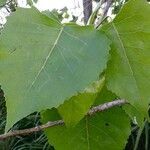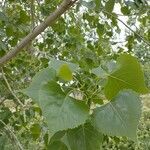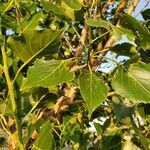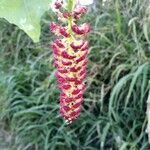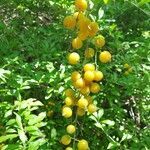Tall tree with ± spreading branches and a broad crown, the bark becoming deeply furrowed and nearly black; terminal buds glabrous, viscid; petioles strongly flattened; lvs glabrous, typically broadly deltoid, 8–14 cm, nearly as wide, short-acuminate, broadly truncate or subcordate at base, serrate with incurved, callous-tipped teeth (the largest teeth mostly 2–5 mm deep), generally bearing 2–5 prominent glands on the upper side at the very base; lowest lateral veins of the lvs widely spreading; scales of the catkins fringed; floral disk 1.5–4 mm wide; stamens (30–)40–80; stigmas 3 or 4, broadly dilated; frs ovoid, 3–4-valved, 6–10 mm, on pedicels 3–10 mm, forming a loose raceme; seeds (3–)7–10(–18) per placenta; 2n=38. Low woods and moist prairies and river-banks; Que. and N. Engl. to Fla. and Tex., and w. to the base of the Rocky Mts. Var. deltoides, the eastern cottonwood, widespread in our range, has gray or reddish-brown twigs, glabrous winter-buds, and mostly 3–5 glands at the base of the lvs, the lvs of the short shoots with mostly 15–30 teeth per side. The wholly confluent var. occidentalis Rydb., the Great Plains cottonwood, forming gallery forests along the rivers across the plains, and encroaching into the westerly Great Lakes region, has yellowish twigs, finely pubescent winter buds, mostly only 2 basal glands on the lvs, and mostly only 5–15 teeth on each side of the often more deltoid-ovate and more long-acuminate lvs. (P. sargentii; P. deltoides ssp. monilifera)
Large tree to c. 30 m high, with spreading branches, usually scarcely suckering. Bark grey, fissured. Shoots slightly angular when mature, yellowish grey. Winter buds and very young shoots viscid, glabrous. Young lvs not aromatic. Petiole of mature lvs to 9 cm long, flattened, glabrous. Lamina 5-10.5 × 4-11 cm, broad-deltoid or broad-ovate, reddish brown when young, glabrous except for margin, becoming wholly green; margin with narrow translucent band, crenate-serrate with curved glandular teeth, densely ciliolate when young; base truncate or subcordate, with 2 glands prominently or weakly developed on either side of petiole; apex acuminate. Catkins ♀, pendulous, mostly eventually 15-20 cm long. Rachis glabrous. Bracts 2-3 mm long excluding filiform lobes, glabrous, whitish. Cup-shaped disc 1-2 mm deep, glabrous; margin irregular. Ovary glabrous; stigmas mostly 3-lobed, irregular, large. Capsules containing abundant long white hairs.
Tree, 2-10 m high, terminal buds present; winter buds with several unequal outer scales. Leaves alternate; broadly ovate-triangular, margins coarsely toothed and fringed with hairs, glands at junction of petiole and blade. Inflorescences pendulous, odourless catkins, appearing before leaves. Flowers unisexual, anemophilous; borne in axil of a serrate or laciniate bract; perianth reduced to a cup-like disc. Male flowers with 4-30 or more stamens; filaments free; anthers 2-thecous, oblong to ovate, red. Female flowers ovary sessile or subsessile, 1-locular; ovules many; style very short, 2-4-branched. Fruit a 2-4-valved capsule.
A medium sized tree. It loses its leaves during the year. It grows to 30 m tall. The trunk is 100 cm across. The bark is dark has deep cracks. The crown is broad. The leaves are triangle shaped and 5-10 cm long. The leaf stalk is long and flat. There are 2 or 3 glands on the stalk. The leaf blade is dark green on top and paler underneath. The leaves are hairy when young. The flowers are of one sex and are in catkins. The female flowers can be 20 cm long.
